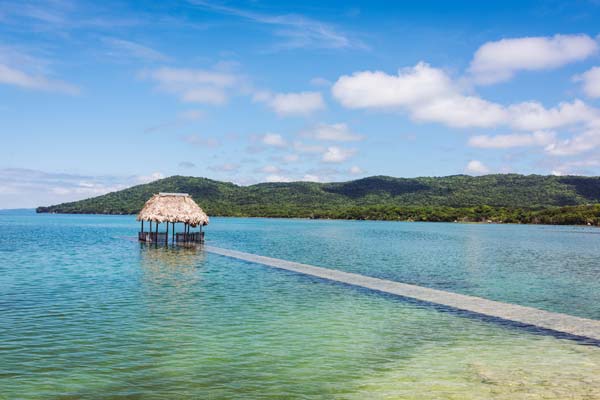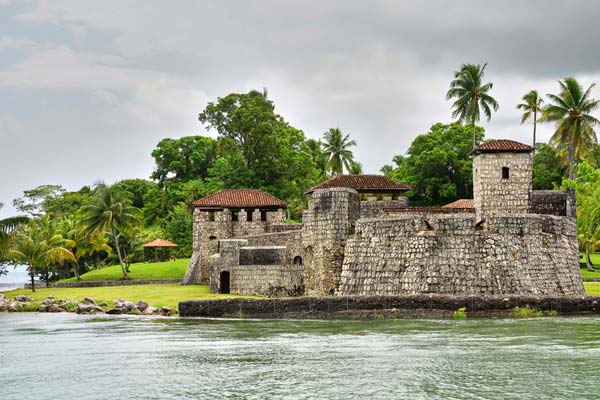The beaches in the Central American country of Guatemala are not as well known for their beauty as those of its neighbors. Its Pacific coast is rugged, with a definite rustic charm, but lacks infrastructure. On the other side of the country, Guatemala’s small frontage on the Caribbean Sea is treasured as a corridor to international shipping, and preserving it for the enjoyment of tourists hasn’t been a priority. But those who dig a little deeper into the country’s options soon find that Guatemala does have three appealing bodies of water, albeit not coastal sites, that are loaded with natural, historical, and cultural rewards. In this case, think lakes, not sea.
Lago de Petén Itzá (Lake Petén Itzá), in the northern lowlands, is less than an hour’s drive to Tikal, Guatemala’s most famous ancient Maya city. In addition to the pristine waters that are perfect for swimming, day-trips around the area showcase the natural beauty of the surrounding jungle flora and its animal inhabitants.
Lago de Izabal stretches from the Caribbean Sea through a series of exceptionally beautiful river gorges to the country’s richest wetland habitat. It’s populated by at least 300 species of birds and is one of the few places you can spot a manatee in the wild.
Over in the cooler climate of the western highlands is Lago de Atitlán (Lake Atitlán). It’s close to the country’s major cities, including the Spanish colonial gem that is Antigua, and is the most visited of the three lakes. It also has exceptional views—you can spend hours just watching the clouds frame the three volcanoes that stand sentinel around the shore.

You can enter the country at its land border with Mexico or Belize, but most visitors arrive at the modern international airport in Guatemala City. From there, internal flights can easily be booked to the town of Flores on Lake Petén Itzá. You can rent a car or hire a private driver to travel to the other lakes or take a comfortable first-class bus. Expect to pay about $2 per hour of bus travel. Lago de Izabal (Lake Izabal) is a five-hour drive from Guatemala City, while the drive to Lake Atitlán is three hours. Accommodation can be found at each location that offers the full range of Western comforts at discount prices.
Lake Petén Itzá

Splashed down in the steamy flatlands of northern Guatemala, Lake Petén Itzá and the surrounding jungle was once the heartland of the Maya empire. While the majority of visitors justifiably prioritize a visit to the towering pyramids of Tikal, hundreds of crumbling archaeological sites have been charted in the region.
Flores, a small, picturesque island town abutting the western shores of the lake, is a popular base for visiting these Maya sites. It has a growing number of quality dining experiences (my family loved the big, American-style breakfasts at Cool Beans for $3) and hotel options for all budgets (clean, comfortable rooms in a 3-star hotel can be had for less than $50 per night).
Flores is also a great place to hire a lancha (small boat) to explore other attractions on the lake. Both of my children love animals and enjoyed visiting the ARCAS animal rescue center and the Petencito Zoo. The rescue center accepts volunteers to work with the animals that can’t be released into the wild. On our way back to Flores, we had our boat captain drop anchor so we could have a refreshing swim in the turquoise waters.
The village of San Miguel, also easily reachable by lancha from Flores, is the starting point for a shaded walk to a wooden lookout tower with fantastic views. A trail from the lookout leads to the lake edge where you can swim at the small public beach called La Playita. Before heading back, enjoy one of the cold sodas that you can purchase from entrepreneurial locals who haul the returnable glass bottles over the same hiking trail. It can’t be easy—they earn their cut.
For a more tranquil setting, try the rural village of El Remate. Located on the only road leading from Flores to Tikal, El Remate has eco-friendly hotels, a first-rate dining option in Restaurante Mon Ami (specializing in French cuisine), and workshops selling local wood carvings.
A one-room apartment at the Posada del Cerro costs $40 a night. The hotel is next to the Cerro Cahui wildlife conservation area. This undisturbed tropical forest has three miles of nature trails and provides the best opportunities in the area for birdwatching or to spot one of the colonies of wild howler monkeys that roam through the jungle.
Lake Izabal

Guatemala’s largest lake stretches almost 24 miles west from the Caribbean Sea to the wetland habitat of the Reserva Bocas del Polochic. It’steeped in natural beauty and colonial history. Nevertheless, Lake Izabal is more suited to sightseeing than swimming, as areas of the lake are visibly polluted.
Tropical vegetation cascades from the treetops.
Fortunately, the sights do not disappoint. Beginning at the coastal town of Livingston, the Río Dulce (literally, sweet river) climbs inland through a series of mesmerizing gorges where tropical vegetation cascades from the treetops and white herons and sea eagles dart over the water. Several jungle lodges in the gorge offer reasonably priced and comfortable accommodation. Many rent kayaks so guests can explore the myriad tributaries that meander like spaghetti noodles into the jungle.
West of the gorge stands the colonial fortress San Félipe. Built by the Spanish to thwart marauding English pirates, it marks the entrance to the lake from the river. For a $3 entrance fee, you can wander its series of dark, maze-like hallways for respite from the afternoon humidity. Views of the lake from the cannon emplacements are outstanding.
Río Dulce town is the place to book excursions on the lake. Transport can be arranged from the town dock. An abundance of hotels sprinkles the shores opposite town. My family and I liked the boardwalks at Hacienda Tijax Hotel with views into the tidal marsh that led from our cozy A-frame cabin to the pool.
At the far western end of the lake, the village of El Estor sits on the threshold of a wetland reserve. The village got its name, “the store,” from pirates who sailed into the lake and raided it for supplies. My family and I hired a lancha to cruise the waters of the Bocas del Polochic reserve. After a breakfast of warm bread and coffee taken in the boat under the sleepy eyes of dozens of howler monkeys who lazed in the trees, we were thrilled to spot a female manatee and her young calf making their morning rounds.
A nearby hot spring waterfall—El Paraiso—is an easy trip from El Estor. The jungle setting and warm water make for a nice spot for a picnic and swim. If you have the nerve, you can even jump from the top of the waterfall into the deep, cool water pool at its base.
Lake Atitlán

Most descriptions of Lake Atitlán and the many villages sprinkled along its shores start with the phrase “there isn’t much to do here.” Yet it remains the most visited of Guatemala’s lakes. So, what gives?
Proximity to Guatemala City and Antigua’s flourishing expat communities mean it is easy to reach. Another reason must be that there isn’t a bad view from any point on the lake. A search on Airbnb will pull up dozens of houses for rent that boast of stunning vistas of the three volcanoes and other less-threatening peaks that hem the lake in. This makes hanging out in a hammock with a book and a glass of wine a very acceptable and popular way to spend an afternoon. And as long as you’re not expecting to party all night or shop all day, there’s plenty to observe and learn from. In the mornings, we took pleasant walks along the dozens of footpaths tamped down by the Kaqchikel people, a subset of the Maya culture whose ancestors settled in the area centuries ago. Each day we watched children in brightly colored traditional clothing scour the hillsides for firewood. For a more adventurous walking experience, several tour operators in the village of San Pedro La Laguna guide hikes on the San Pedro volcano.
Lake Atitlán is deep, measuring more than 800 feet down in some places. This makes the water cold, and we couldn’t tolerate more than a quick dip from the dock of our rented house. But it was the perfect way to cool off before heading to the kitchen for our lesson with the house cook where we learned to make sweetcorn tamales and a traditional chicken stew (we asked to go light on the chiles). Of course, the best part was eating what we had helped make.
The shores of this scenic caldera lake are dotted with small villages where indigenous Maya people share space with artistic and spiritually minded foreigners. It’s easy to arrange a lancha from nearby Panajachel (locally known as Pana) for trips around the lake. We visited two villages, San Juan La Laguna and San Marcos La Laguna. The former specializes in woven mats made with reeds taken from the lake, while San Marcos is filled with yoga and meditation centers. Grab an ice cream and head to the beach or choose a retreat for a massage.
It’s worth spending an afternoon pounding the cobblestones in Pana. It’s the best place to stock up on groceries and wine, and it also has an interesting artisans’ market selling weavings from all over Guatemala. While in Pana, treat yourself to the best pizza in town at Circus Bar.

Get Your Free Report on the World’s Best Places to Retire:
Learn more about the best places in the world to retire in our daily postcard e-letter.
Simply enter your email address below to sign up for our free daily postcards and we’ll also send you a FREE report on The World’s Top 10 Retirement Havens, plus access to over 10 more free reports. Our gift to you, on our favorite destinations.
Related Articles
Exploring Antigua, Guatemala Rent-Free
5 Best Caribbean Islands to Live On… and 2 to Avoid
The Best Towns and Cities to Retire in Mexico and Central America
Upcoming Conferences
The Only 2024 Fast Track Panama Conference
If your dream retirement involves stunning beaches… lush green mountains… a warm climate with no hurricanes… first-rate healthcare… incredible value for money (a couple can live well on $2,200 a month)… and the World’s #1 Retiree Discount Program…
Join our Panama experts and expats in February and discover why Panama could be your perfect paradise.


.png)